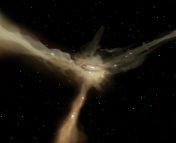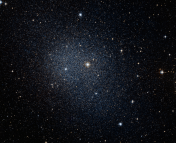Authors: Ivanna Escala, Andrew Wetzel, Evan N. Kirby, Philip F. Hopkins, Xiangcheng Ma, Coral Wheeler, Dušan Kereš, Claude-André Faucher-Giguère, and Eliot Quataert
First Author’s Institution: California Institute of Technology
Status: Published in MNRAS [open access on arXiv]
In studying the universe, astronomers must increasingly make use of all the natural sciences. State-of-the-art simulations of other galaxies now include complicated chemical networks that track the formation and evolution of various elements throughout time and space. Such estimates of elemental abundances play a crucial role in getting accurate measurements of gas cooling, star formation, and other physics. This has proven difficult in large galaxy simulations, though, since finite computational resources limit their resolution. In other words, these simulations cannot currently probe the smaller scales at which chemical formation and evolution occur. Consequently, one must turn to what are known as “subgrid models.”
In today’s paper, the authors investigate the effects of including a subgrid model for turbulent metal diffusion in dwarf galaxies from the FIRE simulations (Fig 1). Let’s break this down. A subgrid model is any computation done below the resolution limit of the simulation. Subgrid, therefore, refers to something done on the scale of an individual resolution element (grid cell, particle, etc) or smaller. In astronomy jargon, metals refer to anything on the periodic table other than hydrogen and helium. Turbulent metal diffusion then means the movement of metals away from their point of origin via the turbulent motion of the surrounding gas. This is akin to giving the galaxy a good shake at each step in the simulation so that the metals spread out.
By including this model, the authors find that the metal distribution function (MDF) of a galaxy in the simulation narrows substantially (Fig 2). This is because the metals end up more smeared throughout the galaxy, so the whole galaxy approaches a single average metallicity. Without turbulent metal diffusion, metals remain in a very clumpy distribution due to the clumpy nature of supernovae and stellar winds. These metals may be stirred some by the rotation of the galaxy, but they will generally stay pretty close to their point of origin. This additional shaking component of the turbulent metal diffusion proves to be much more effective at spreading out the metals.
The authors also find that including such a subgrid model keeps metals relatively well-mixed at all times in the simulation, even during bursty periods of star formation (Fig 3). Bursts of star formation could result in a more clumpy distribution of metals, since the massive stars will quickly (on galactic timescales) produce metals and return them to the local gas via supernovae. The results of this paper, though, show that these local depositions of metals are quickly smeared out. This means that the interstellar medium can be assumed to be relatively well-mixed throughout the evolution of a galaxy. Without metal diffusion, the distribution of metals remains much clumpier in the simulations throughout time.
These results indicate that metal diffusion is an important component to include in modern galaxy simulations. Without such a model, one obtains unrealistically clumpy distributions of metals that don’t match observations. Eventually, simulations may have sufficient resolution so that such a subgrid model is unnecessary. For now, though, ordering a model that leaves the metals shaken, not stirred, seems to do the trick.



